Figure 2. Predicting the FRET efficiency of a construct with two acceptors.
A. Constructs used to study the effects of having two acceptors in a FRET complex. Blue “cans” depict the Cerulean donor, Yellow depicts Venus acceptors, and gray depicts Amber, which has a single point mutation in Venus that prevents it from forming a fluorophore. Arrows leading away from Cerulean represent both radiative and non-radiative emission pathways. Blue arrows show radiative emission when Cerulean emits a photon. Red arrows depict non-radiative pathways for releasing excitation energy involving FRET. B. Table comparing the FRET efficiencies of VCA, ACV, and VCV measured by either sRET or E-FRET, as well as the measured acceptor to donor ratio (A/D) for each construct. C. Energy transfer rates and their propagated error were calculated from the measured Cerulean lifetime of ACA and the FRET efficiencies measured by E-FRET of individual constructs. The Sum column is the arithmetic sum of the VCA and ACV transfer rates with propagated error and by theory should equal the transfer rate measured for VCV.

